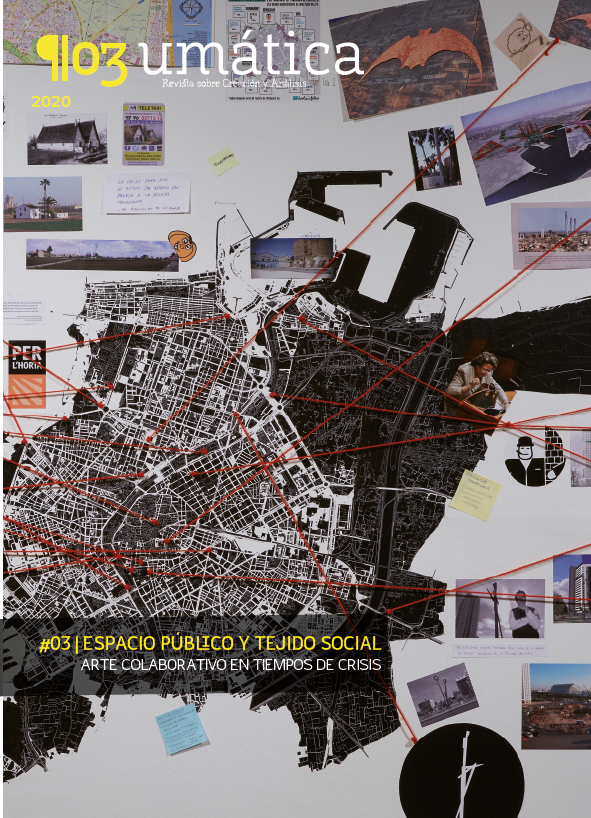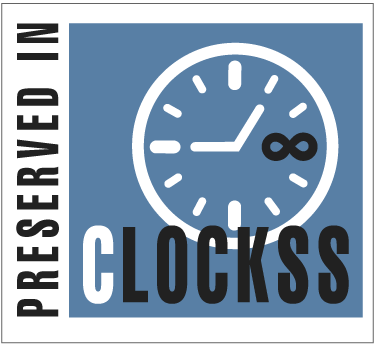Curaduría social en entornos artísticos: Hablar y actuar en las Sullivan Galleries de School of the Arts Institute of Chicago
DOI:
https://doi.org/10.24310/Umatica.2020.v2i3.11185Palabras clave:
Comisariado pedagógico, Arte comprometido socialmente, decolonialidadResumen
En este artículo se presenta la práctica curatorial de Hablar y Actuar. Arte, Pedagogía y Activismo en las Américas a su paso por Sullivan Galleries, la galería de arte de The School of the Art Institute of Chicago en 2018. Tratándose de una exposición dedicada a las practicas artísticas socialmente comprometidas en el continente americano, en el presente texto se analizan los modos curatoriales desarrollados ad hoc para exhibir veintidós proyectos de diversas procedencias geográficas a través de lógicas y métodos decoloniales, aprendidos a través del estudio de las obras seleccionadas y de sus metodologías de producción artística.
Descargas
Métricas
Publicación Facts
Perfil de revisores N/D
Información adicional autores
Indexado: {$indexList}
-
Indexado en
- Sociedad Académica/Grupo
- N/D
- Editora:
- Universidad de Málaga (España)
Citas
Bal, M., (1996). «The discourse of the museum». In Greenberg, R., Ferguson, B. et al (Eds.) Thinking about Exhibitions (pp.145–157). New York: Routledge.
Bishop, C. (2014) Radical Museology: Or, What's 'contemporary' In Museums Of Contemporary
Art? London: Koenig.
Boast, R. (2011). «Neo-colonial collaborations: Museum as Contact Zone Revisited». Museum
Anthropology, Vol. 34, No. 1
Camnitzer, L., «Las fronteras de la curaduría». Texto dentro del encuentro internacional
MDE11, Medellín, documento electrónico: https://vimeo.com/29385162
Cartagena, M.F. (2017). «Liberation Aesthetics: Social Transformation, Decolonization, and Interculturality». En Kelley Jr., B. y Zamora, R. (Eds.), Talking to Action: Art, Pedagogy, and Activism in the Americas, (pp.63-70). Chicago: The University of Chicago Press.
Clifford, J. (1997) «Museums as Contact Zones». En Clifford, J. (Ed.) Routes: Travel and Translation in the Late Twentieth Century (pp. 188–219). Cambridge: Harvard University Press.
Fanon, F. (1963) The Wretched of the Earth. London: Penguin.
Filipovic, Y. (2013). Necessarily Cumbersome, Messy, and Slow: Community Collaborative Work within Art Institutions. Journal of Museum Education, 38(2), 129-140.
Fraser, M., & Ming Wai Jim, A. (2018). What is critical curating?: Introduction. RACAR : Revue d’art Canadienne / Canadian Art Review. 43(2), 102–103.
Freire, P. (1970), Cultural Action for Freedom. Massachusetts: Harvard Educational Review.
Gaztambide-Fernández, R. (2014). Decolonial options and artistic/aestheSic entanglements: An interview with Walter Mignolo. Decolonization: Indigeneity, Education & Society. Vol. 3, No. 1, 196-212.
Hooper-Greenhill, E. (2006). «The power of museum pedagogy». En Hugh H. Genoways (Ed.), Museum philosophy for the twenty-first century, (pp.235-245). Altamira Press.
Jacob, M. J. (2018), Dewey for Artists. Chicago: University of Chicago Press.
Kelley Jr., B. (2017). «Talking to Action: A Curatorial Experiment Towards Dialogue and
Learning». En Kelley Jr., B. y Zamora, R. (Eds.), Talking to Action: Art, Pedagogy, and Activism in the Americas, (pp.7-16). Chicago: The University of Chicago Press.
Kester, G. (2011) The One and the Many . Durham and London: Duke University Press.
Mignolo, W y Nanibush, W. (2018). Thinking and Engaging with the Decolonial: A Conversation Between Walter D. Mignolo and Wanda Nanibush. Afterall. Spring/Summer (45), 25-29.
Mörsch, C. (2015) «Contradecirse a una misma. Museos y Mediación educativa crítica». En Contradecirse a una misma. Museos y Mediación educativa crítica. Experiencias y Reflexiones desde las educadoras de la documenta 12. Quito: Quito Alcaldía.
Phillips, R. B. (2020). «Can Museums be Postcolinal? ». En Coombes y Phillips (eEds.) Museum Transformations: Decolonization and Democratization. West Sussex, UK: Wiley Blackwell
Roche Rodríguez, M. (2018). Remedios Zafra: La opresión simbólica está en la normalización del imaginario de poder que hace incuestionable lo ‘convenido’. Colofón Revista Literaria. Enero (26).
Simon, N. (2016) The Art of Relevance. Santa Cruz: Museum 2.0.
Smith, L. T. (2012). Decolonizing Methodologies. Research and Indigenous Peoples. London and New York: Zed Books.
Stott, T., y Kester, G., (2006), An Interview with Grant Kester. Circa Art Magazine. Autumn, No. 117. pp. 44-47
Entrevista con Bill Kelley Jr., 25 de marzo de 2021.
Publicado
Cómo citar
Número
Sección
Licencia
Todos los contenidos publicados en Umática.Revista sobre Creación y Anáisis de la Imágen están sujetos a la licencia Creative Commons Reconocimento-NoComercia-Compartirigual 4.0 cuyo texto completo puede consultar en <http://creativecommons.org/licenses/by-nc-sa/4.0>
Se pueden copiar, usar, difundir, transmitir y exponer públicamente, siempre que:
- Se cite la autoría y la fuente original de su publicación (revista, editorial y URL de la obra).
- No se usen para fines comerciales.
- Se mencione la existencia y especificaciones de esta licencia de uso.
Los derechos de autor son de dos clases: morales y patrimoniales. Los derechos morales son prerrogativas perpetuas, irrenunciables, intransferibles, inalienables, inembargables e imprescriptibles. De acuerdo con la legislación de derechos de autor,Umática.Revista sobre Creación y Anáisis de la Imágen reconoce y respeta el derecho moral de los autores/as, así como la titularidad del derecho patrimonial, el cual será cedido a la Universidad de Málaga para su difusión en acceso abierto. Los derechos patrimoniales, se refieren a los beneficios que se obtienen por el uso o divulgación de las obras. Umática.Revista sobre Creación y Anáisis de la Imágen se publica en open access y queda autorizada en exclusiva para realizar u autorizar por cualquier medio el uso, distribución, divulgación, reproducción, adaptación, traducción o transformación de la obra.
Es responsabilidad de los autores/as obtener los permisos necesarios de las imágenes que están sujetas a derechos de autor.
Nota de copyright: Aquellos autores/as que tengan publicaciones con esta revista, aceptan y certifican los términos siguientes:
• Que ha contribuido directamente al contenido intelectual del trabajo, del cual se hace responsable a todos los efectos.
• Que aprueba los contenidos del manuscrito que se somete al proceso editorial de la revista UMÁTICA, REVISTA SOBRE CREACIÓN Y ANÁLISIS DE LA IMAGEN, y por tanto está de acuerdo en que su nombre figure como autor.
• Que el contenido del artículo no ha sido publicado y que tampoco figura en otro trabajo que esté a punto de publicarse.
• Que se compromete a no someterlo a consideración de otra publicación mientras esté en proceso de dictamen en la revista UMÁTICA, REVISTA SOBRE CREACIÓN Y ANÁLISIS DE LA IMAGEN, ni posteriormente en caso de ser aceptado para su publicación.
• Que no ha tenido ni tiene, relaciones personales o financieras que puedan introducir prejuicios y sesgos en el desarrollo o los resultados del presente trabajo.
• Que han sido mencionadas en el epígrafe de agradecimientos todas aquellas personas que, habiendo otorgado su permiso para tal mención, han contribuido de manera sustancial al desarrollo del trabajo.
• Que se compromete a facilitar, cuando así lo requiera la revista, el acceso a todos los datos y fuentes en los que se funda el trabajo presentado.
• Que participará activamente en la realización de todas aquellas modificaciones de estilo u orto-tipográficas que sean necesarias para la publicación del trabajo cuando así se lo notifique el equipo editorial de la revista.
• Que no ha violado, ni violará, las leyes y derechos humanos o animales durante el proceso de investigación y publicación de este trabajo.
• Que ninguna de las instituciones en las que desarrolla su labor científica e investigadora ha presentado objeciones con respecto a la publicación del manuscrito que se somete a evaluación.
• Que todos los datos y las referencias a materiales ya publicados están debidamente identificados con su respectivo crédito e incluidos en las notas bibliográficas y en las citas que se destacan como tal y, en los casos que así lo requieran, cuenta con las debidas autorizaciones de quienes poseen los derechos patrimoniales.
• Que los materiales están libres de derecho de autor y se hace responsable de cualquier litigio o reclamación relacionada con derechos de propiedad intelectual, exonerando de responsabilidad a la revista UMÁTICA, REVISTA SOBRE CREACIÓN Y ANÁLISIS DE LA IMAGEN
• Que en caso de que el trabajo sea aprobado para su publicación, autoriza de manera ilimitada en el tiempo a la entidad editora para que incluya dicho texto en la revista UMÁTICA, REVISTA SOBRE CREACIÓN Y ANÁLISIS DE LA IMAGEN y pueda reproducirlo, editarlo, distribuirlo, exhibirlo y comunicarlo en el país y en el extranjero por medios impresos, electrónicos, CD, Internet o cualquier otro medio conocido o por conocer.







23.png)








